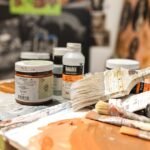June Adair Black made tracks across the country.
Using delicate instruments and a mountain of modeling clay, she carved out a niche in a male-dominated business to become the only woman in her field during the 1950s and 1960s.
Black worked as a “tire sculptress” for Firestone, Goodyear and Goodrich in Akron.
“I always wanted to go into industry and I feel that I’ve found a good job with a good future,” Black once explained. “There’s always work to be done on new tires.”
Her occupation was so novel that U.S. newspapers published several articles about her over the years.
The headlines included:
“Akron Woman Has Odd Job.”
“What’s Her Line? Well, One You Might Never Suspect.”
“Like Your Pretty New Tires, Boys? Meet the Girl Who Designed Them.”
Early life in Ghent
June Ellen Adair, the youngest daughter of Genevieve and Edward J. Adair, was born June 23, 1924, in the Bath Township hamlet of Ghent. She grew up with her sisters Evelyn and Elaine near the present-day intersection of Ghent Road and Cleveland-Massillon Road and lived there her whole life.
The Adairs owned property at the triangle formed by routes 21 and 176, and leased the land to Firestone Tire & Rubber Co., which built a gigantic sign depicting a rolling tire. Maybe it served as an inspiration.
The family opened Adair’s Drive-In, which later became Jimbo’s, a popular eatery for decades. Today, the Ghent site is home to Corner Provisions, a commercial building featuring Pitchfork, Pav’s Creamery, Eden, Corner Club, Cafe 36 and Upper Desk.
June Adair was a 1942 graduate of Bath High School and a 1948 graduate of the Cleveland Institute of Art, where she majored in industrial design as the only woman in her class.
She taught ceramic art at the Akron Art Institute before joining Firestone in 1949 as a “tire sculptress.” The only woman in the country with that job title, she was responsible for creating clay models of tires for cars, trucks and tractors.
“The models help development engineers and management visualize new tire profiles and tread designs,” she noted. “The models make it easier to alter proposed designs before they are molded in rubber for testing.”
The art of sculpting tires
She took modeling clay and applied it to a wooden form, pummeling it with her fists and hammering it with a mallet to smooth it out. Analyzing reference photos of new tread and sidewall designs, she carefully used molding tools to re-create the geometric patterns.
“Believe me, it’s an art,” she said. “Every squiggle on a tire tread serves a definite purpose.”
Her quarter-section replicas, which took about a week to produce, had to be accurate to the hundredth of an inch, requiring careful measurements with calipers. She painted the clay black to make it look like a real tire.
The artist sculpted about 52 models a year — one per week.
“I love my job,” she said. “It’s exactly what I’ve always wanted.”
In 1955, the Firestone employee married Massachusetts native Donald Black, a chemical engineer at Goodyear. They built a house next to her childhood home, and it still stands today on Ghent Road.
‘A damsel with dainty hands’
International News Service correspondent Phyllis Battelle interviewed June Black for a feature story in 1957. The reporter described the artist as “a damsel with dainty hands and the patience of a flagpole sitter.”
Black sat on a leather-cushioned stool and demonstrated her step-by-step process for hammering, smoothing and sculpting. She was particularly pleased with the model she had created that week.
“I think this one’ll be good,” Black told the reporter. “Plenty of tire surface on the road, should wear forever. Also, it’s pretty.”
Tire aesthetics were important to 1950s consumers, she explained.
“I understand only 16% of the tires sold are bought by women, but you’d be surprised how design-conscious men are,” Black said. “Well, after all, if you have a big, beautiful car you may as well have a set of big, beautiful tires on it. Don’t you think?”
Goodyear and Goodrich
After 15 years at Firestone, Black branched off on her own in the 1960s. She became a freelancer, creating tire models for Goodyear and Goodrich from the comfort of her basement workshop on Ghent Road.
“I would like to say once more that we are very pleased with your work,” W.J. Lee, Goodyear director of tire development, wrote in a 1964 letter. “… We want another model.”
He enclosed a check for $175. That’s nearly $1,800 in today’s money.
Goodyear furnished scale drawings of tire tread and sidewalls to be carved, and provided the wooden forms on which the models were made, but Black had to lug them back and forth to her home.
If changes were later needed, Goodyear paid her $4.50 an hour (more than $45 today) to make the modifications.
The money was good. By the end of the decade, Black drove around town in a brand-new 1969 Chevrolet Impala convertible in butternut yellow.
Her husband, Don, an engineer for Sun Oil Co. and volunteer firefighter for Bath Township, died in 1975 at age 49 after a bout with cancer. The couple did not have children.
June Black continued to live in their Ghent Road home, building clay models into the 1980s before eventually hanging up her sculpting tools. She passed away Oct. 9, 2019, at age 95, joining her husband at Rose Hill in Fairlawn.
Niece remembers Aunt June
Her niece Sally Windate, 76, a ceramic artist in Ghent, is heir to Aunt June’s work instruments and collection of memorabilia, including newspaper clippings and vintage photos of her on the job.
The pictures reveal a perfectly coiffed woman who liked to wear fashionable clothes, festive scarves and decorative brooches. She didn’t seem concerned about getting smudged with clay or paint.
“It’s amazing to me that she dressed up every day,” Windate said.
Glancing at her aunt’s 1963 resume, she laughed when she saw that Black had included her age (39), height (5-foot-3), weight (122 pounds) and marital status (married, no children).
“You wouldn’t be able to tell any of that stuff today,” she said.
Windate, whose mother was the former Elaine Adair, remembers the old neighborhood: The giant Firestone sign, Adair’s Drive-In, Jimbo’s, her grandparents’ house. In 1943, her father, Vernon Wilson, built Wilson’s Garage, which he owned until retiring in 1986. The garage is still in operation on Cleveland-Massillon Road.
She also recalls going to Aunt June’s basement to help her on a tire model.
“My job was to pound the clay on the mold,” Windate said. “She had to measure how thick it was and then she smoothed it all out.”
The nation’s only “tire sculptress” just loved her job.
“She was really proud of it, and she should have been,” Windate said. “She was the only woman there.”
Mark J. Price can be reached at mprice@thebeaconjournal.com
More: 20 things that only an Akron resident would understand
More: What do you say? The ultimate pronunciation guide to Akron











